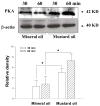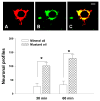The role of c-AMP-dependent protein kinase in spinal cord and post synaptic dorsal column neurons in a rat model of visceral pain
- PMID: 17320244
- PMCID: PMC1894916
- DOI: 10.1016/j.neuint.2007.01.006
The role of c-AMP-dependent protein kinase in spinal cord and post synaptic dorsal column neurons in a rat model of visceral pain
Abstract
Visceral noxious stimulation induces central neuronal plasticity changes and suggests that the c-AMP-dependent protein kinase (PKA) signal transduction cascade contributes to long-term changes in nociceptive processing at the spinal cord level. Our previous studies reported the clinical neurosurgical interruption of post synaptic dorsal column neuron (PSDC) pathway by performing midline myelotomy effectively alleviating the intractable visceral pain in patients with severe pain. However, the intracellular cascade in PSDC neurons mediated by PKA nociceptive neurotransmission was not known. In this study, by using multiple experimental approaches, we investigated the role of PKA in nociceptive signaling in the spinal cord and PSDC neurons in a visceral pain model in rats with the intracolonic injection of mustard oil. We found that mustard oil injection elicited visceral pain that significantly changed exploratory behavior activity in rats in terms of decreased numbers of entries, traveled distance, active and rearing time, rearing activity and increased resting time when compared to that of rats receiving mineral oil injection. However, the intrathecal infusion of PKA inhibitor, H89 partially reversed the visceral pain-induced effects. Results from Western blot studies showed that mustard oil injection significantly induced the expression of PKA protein in the lumbosacral spinal cord. Immunofluorescent staining in pre-labeled PSDC neurons showed that mustard oil injection greatly induces the neuronal profile numbers. We also found that the intrathecal infusion of a PKA inhibitor, H89 significantly blocked the visceral pain-induced phosphorylation of c-AMP-responsive element binding (CREB) protein in spinal cord in rats. The results of our study suggest that the PKA signal transduction cascade may contribute to visceral nociceptive changes in spinal PSDC pathways.
Figures




Similar articles
-
Effects of general anesthetics on visceral pain transmission in the spinal cord.Mol Pain. 2008 Oct 30;4:50. doi: 10.1186/1744-8069-4-50. Mol Pain. 2008. PMID: 18973669 Free PMC article. Review.
-
Protein kinases mediate increment of the phosphorylation of cyclic AMP-responsive element binding protein in spinal cord of rats following capsaicin injection.Mol Pain. 2005 Sep 13;1:26. doi: 10.1186/1744-8069-1-26. Mol Pain. 2005. PMID: 16159392 Free PMC article.
-
Pelvic visceral input into the nucleus gracilis is largely mediated by the postsynaptic dorsal column pathway.J Neurophysiol. 1996 Oct;76(4):2675-90. doi: 10.1152/jn.1996.76.4.2675. J Neurophysiol. 1996. PMID: 8899637
-
Activation of extracellular signal-regulated protein kinases 5 in the spinal cord contributes to the neuropathic pain behaviors induced by CCI in rats.Neurol Res. 2009 Dec;31(10):1037-43. doi: 10.1179/174313209X405128. Epub 2009 May 8. Neurol Res. 2009. PMID: 19426589
-
A visceral pain pathway in the dorsal column of the spinal cord.Proc Natl Acad Sci U S A. 1999 Jul 6;96(14):7675-9. doi: 10.1073/pnas.96.14.7675. Proc Natl Acad Sci U S A. 1999. PMID: 10393879 Free PMC article. Review.
Cited by
-
Enhanced spinal neuronal responses as a mechanism for increased number and size of active acupoints in visceral hyperalgesia.Sci Rep. 2020 Jun 25;10(1):10312. doi: 10.1038/s41598-020-67242-9. Sci Rep. 2020. PMID: 32587303 Free PMC article.
-
Involvement of mGluR5 and TRPV1 in visceral nociception in a rat model of uterine cervical distension.Mol Pain. 2018 Jan-Dec;14:1744806918816850. doi: 10.1177/1744806918816850. Epub 2018 Nov 16. Mol Pain. 2018. PMID: 30444177 Free PMC article.
-
Estrogen alters spinal NMDA receptor activity via a PKA signaling pathway in a visceral pain model in the rat.Pain. 2008 Jul 31;137(3):540-549. doi: 10.1016/j.pain.2007.10.017. Epub 2008 Feb 20. Pain. 2008. PMID: 18068901 Free PMC article.
-
Roles of phosphotase 2A in nociceptive signal processing.Mol Pain. 2013 Sep 8;9:46. doi: 10.1186/1744-8069-9-46. Mol Pain. 2013. PMID: 24010880 Free PMC article. Review.
-
Effects of general anesthetics on visceral pain transmission in the spinal cord.Mol Pain. 2008 Oct 30;4:50. doi: 10.1186/1744-8069-4-50. Mol Pain. 2008. PMID: 18973669 Free PMC article. Review.
References
-
- Al Chaer ED, Lawand NB, Westlund KN, Willis WD. Pelvic visceral input into the nucleus gracilis is largely mediated by the postsynaptic dorsal column pathway. J Neurophysiol. 1996;76:2675–2690. - PubMed
-
- Becker R, Gatscher S, Sure U, Bertalanffy H. The punctate midline myelotomy concept for visceral cancer pain control--case report and review of the literature. Acta Neurochir Suppl. 2002;79:77–78. - PubMed
-
- Becker R, Sure U, Bertalanffy H. Punctate midline myelotomy. A new approach in the management of visceral pain. Acta Neurochir (Wien) 1999;141:881–883. - PubMed
Publication types
MeSH terms
Substances
Grants and funding
LinkOut - more resources
Full Text Sources
Medical

